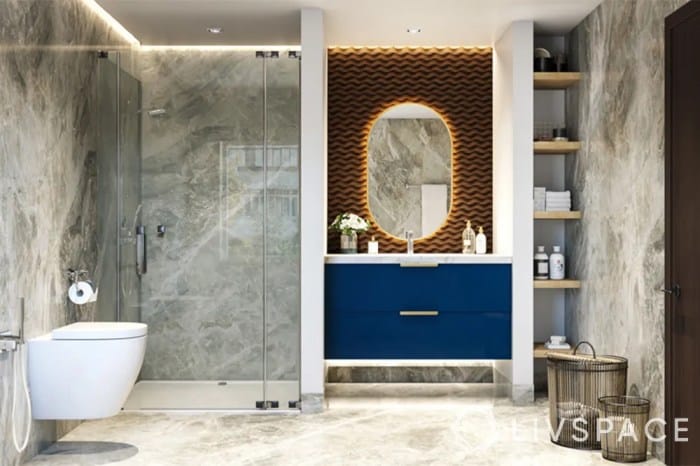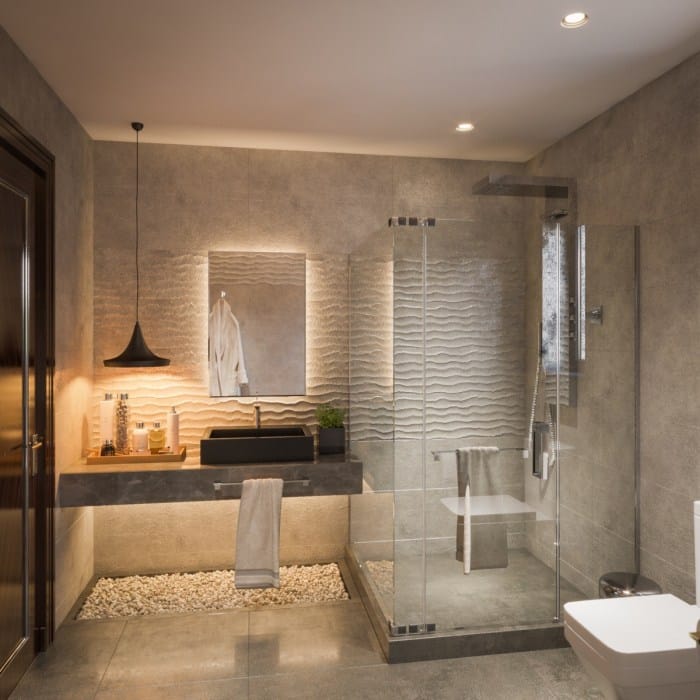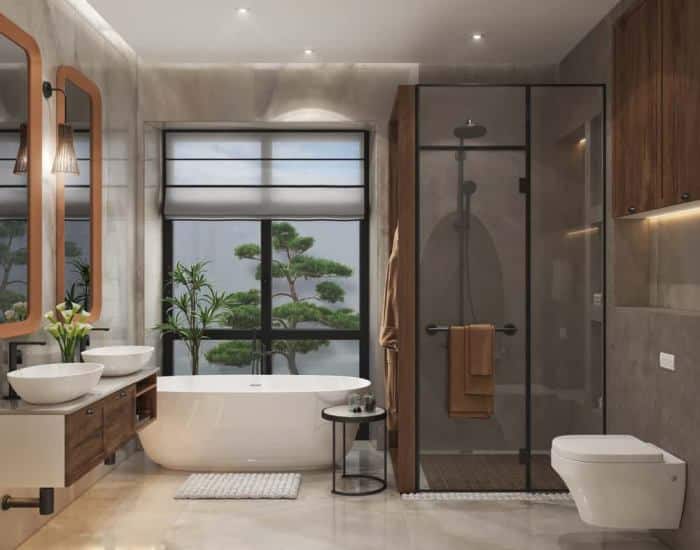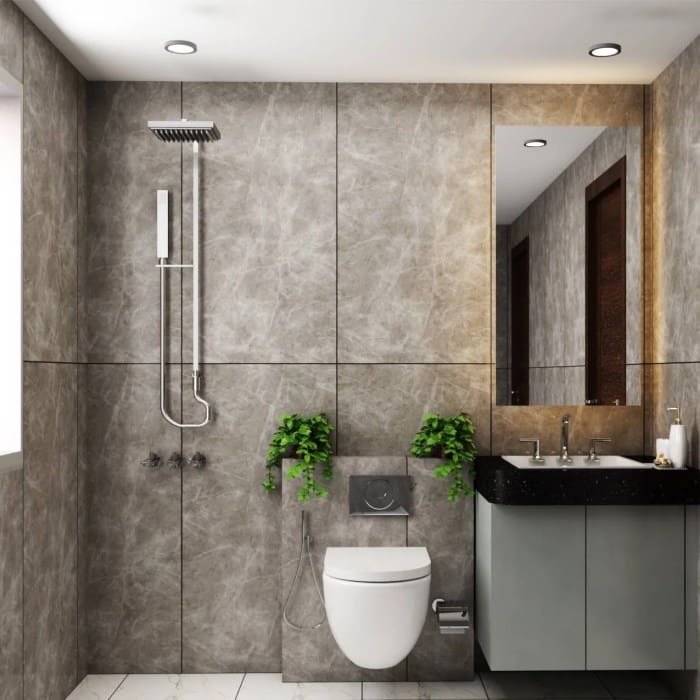The contemporary bathroom transcends the sterile, all-white aesthetic. A new wave embraces the unfinished, celebrating the raw beauty of exposed materials and industrial elements. This design philosophy isn’t about neglect; it’s a carefully curated approach, balancing exposed textures like concrete or brick with thoughtfully chosen fixtures and lighting to create spaces that are both striking and functional. We delve into the science of light and material interplay, exploring how seemingly disparate elements harmonize to achieve a sophisticated, lived-in feel.
From the durability of concrete to the warmth of reclaimed wood, material selection plays a pivotal role. The strategic use of lighting dramatically alters the perception of space, highlighting textures and creating specific ambiances. Clever storage solutions maintain the unfinished aesthetic while ensuring practicality. This exploration will reveal how to successfully integrate natural elements, such as plants, to soften the industrial edge, ultimately creating a sanctuary that’s both stylish and uniquely personal.
Trending Materials & Finishes in Unfinished Bathrooms
The contemporary unfinished bathroom trend embraces raw materials and industrial aesthetics, moving away from the traditionally polished and concealed approach. This design philosophy celebrates the inherent beauty of natural and manufactured materials, showcasing their texture and inherent imperfections. The result is a space that feels authentic, unique, and surprisingly sophisticated.
The choice of materials significantly impacts the overall look and feel of an unfinished bathroom. Durability, cost-effectiveness, and aesthetic appeal are key considerations. The following analysis examines popular materials and their properties.
Material Properties in Unfinished Bathroom Design
The following table compares the durability, cost, and aesthetic appeal of popular materials used in contemporary unfinished bathroom designs. Note that cost can vary significantly based on quality, sourcing, and installation.
| Material | Durability | Cost | Aesthetic Appeal |
|---|---|---|---|
| Concrete | High; resistant to water damage with proper sealing. | Moderate to High; varies based on finish and installation. | Industrial, modern, minimalist; can be polished for a sleek look or left raw for a more rustic feel. |
| Exposed Brick | High; naturally durable but may require sealing to prevent moisture absorption. | Moderate; cost depends on the type of brick and installation complexity. | Rustic, industrial, vintage; offers a warm, textured backdrop. |
| Natural Stone (e.g., slate, marble) | High; naturally durable but requires sealing to protect against staining. | High; varies greatly depending on the type and quality of stone. | Luxurious, sophisticated, natural; adds a touch of elegance and timeless appeal. |
| Reclaimed Wood | Moderate; requires proper treatment for moisture resistance. | Moderate to High; cost varies based on type and condition of wood. | Rustic, organic, warm; creates a unique and characterful space. |
Achieving a Polished Unfinished Look
The key to a successful unfinished bathroom lies in the thoughtful juxtaposition of raw and refined elements. Textural contrasts play a crucial role in creating visual interest and a sense of balance. For instance, the rough texture of exposed brick can be beautifully complemented by the smooth surface of a concrete countertop or the sleek lines of minimalist plumbing fixtures.
Consider incorporating polished metal accents, such as chrome or brushed nickel, against the backdrop of raw materials. This interplay of textures prevents the space from feeling overly industrial or unfinished. Strategic lighting can also enhance the aesthetic, highlighting the textures and creating a warm, inviting ambiance.
Unique Plumbing Fixture Finishes
Plumbing fixtures offer an opportunity to introduce pops of color or unique finishes that complement the overall aesthetic of an unfinished bathroom. Instead of traditional chrome or brushed nickel, consider:
Matte black fixtures offer a sophisticated and slightly edgy contrast against raw materials. Their dark color adds depth and visual weight, balancing lighter materials like exposed brick or reclaimed wood. Imagine a matte black faucet against a backdrop of light-colored concrete walls.
Copper or brass fixtures introduce warmth and a touch of vintage charm. These metallic finishes age beautifully, developing a unique patina over time, which complements the inherent imperfections of unfinished materials. A copper sink paired with exposed brick walls would create a visually stunning and cohesive design.
Concrete sinks or basins provide a seamless integration with the overall design, enhancing the industrial aesthetic. Their monolithic form complements the raw, unadorned quality of an unfinished bathroom, creating a unified and visually appealing space. The texture and color of the concrete sink can be customized to match the surrounding concrete walls or flooring.
Design Elements for an Unfinished Aesthetic
The allure of an unfinished bathroom lies in its raw, authentic appeal. It’s a space where the process of creation is celebrated, rather than concealed. Achieving this aesthetic requires a careful consideration of design elements, particularly lighting, storage, and the overall color palette and material choices. The goal is to create a space that feels both functional and visually interesting, showcasing the inherent beauty of imperfectly perfect materials.
Strategic lighting plays a crucial role in enhancing the unfinished aesthetic. The principle of highlighting textures is paramount. Direct, harsh lighting should be avoided, as it can flatten surfaces and detract from the natural variations in materials. Instead, layered lighting—combining ambient, task, and accent lighting—creates depth and visual interest. Ambient lighting, such as recessed fixtures or strategically placed sconces, provides a soft, overall illumination.
Task lighting, like a vanity light with adjustable brightness, ensures adequate illumination for specific tasks. Accent lighting, such as strategically placed spotlights, can highlight unique textures in exposed brick, concrete, or reclaimed wood.
Lighting Strategies for Unfinished Bathrooms
The interplay of light and shadow is key to enhancing the raw texture of unfinished materials. For instance, a rustic bathroom featuring exposed brick walls could benefit from warm-toned, low-intensity lighting to accentuate the uneven surface and create a cozy atmosphere. Conversely, a minimalist unfinished bathroom with polished concrete floors might use cooler, brighter lighting to emphasize the smooth, sleek surfaces.
The scientific principle at play here is the way light interacts with different surface textures and colors, creating a perception of depth and dimension. The use of dimmers allows for flexibility in adjusting the ambiance, transforming the space from bright and airy to moody and intimate.
Storage Solutions for Maintaining an Unfinished Feel
Open shelving provides a straightforward and visually appealing storage solution that complements the unfinished aesthetic. Raw wood shelves, perhaps slightly distressed or reclaimed, can add to the overall rustic charm. Metal shelving, especially in industrial styles, offers a contrasting texture and a clean, minimalist feel. For a more refined approach, industrial-style metal cabinets with a slightly rusted or aged finish can add a touch of vintage appeal while maintaining ample storage.
The key is to avoid overly polished or pristine storage solutions; the aim is to maintain the raw and authentic feel of the space.
Mood Board Examples: Unfinished Bathroom Styles
The following Artikels three distinct mood boards, each representing a different interpretation of the unfinished bathroom aesthetic.
Mood Board 1: Minimalist Unfinished Bathroom
This mood board emphasizes clean lines, simple forms, and a limited color palette. The color scheme is predominantly neutral, featuring shades of white, gray, and muted beige. Materials include polished concrete flooring, white subway tiles (perhaps with some intentional imperfections), and sleek, minimalist metal fixtures. The overall vibe is serene, functional, and uncluttered. The lighting scheme focuses on clean, bright LED fixtures for a modern, minimalist touch.
Mood Board 2: Industrial Unfinished Bathroom
This mood board embraces the raw textures and industrial elements of exposed brick, metal piping, and reclaimed wood. The color palette incorporates deep grays, metallic accents (like copper or galvanized steel), and touches of black. Materials include exposed brick walls, dark-stained reclaimed wood shelving, and industrial-style metal fixtures. The overall vibe is edgy, masculine, and full of character.
The lighting scheme employs a mix of industrial-style pendant lights and strategically placed spotlights to highlight the textures of the materials.
Mood Board 3: Rustic Unfinished Bathroom
This mood board focuses on natural textures and warm, earthy tones. The color palette features warm browns, creams, and muted greens. Materials include reclaimed wood beams, stone or ceramic tile flooring, and natural fiber accents like woven baskets. The overall vibe is cozy, inviting, and grounded in nature. The lighting scheme employs warm-toned bulbs in sconces and pendant lights to create a relaxing and intimate atmosphere.
The use of natural light is maximized through large windows.
Plumbing & Fixtures in Contemporary Unfinished Bathrooms

The aesthetic of a contemporary unfinished bathroom hinges on a delicate balance: showcasing the raw, industrial elements while maintaining a sense of sophistication and functionality. Plumbing and fixtures play a crucial role in achieving this balance, offering opportunities to enhance the design’s unique character. The choice between exposed and concealed plumbing, in particular, significantly impacts the overall visual impact and the narrative the bathroom tells.The strategic integration of plumbing and fixtures can transform a space from merely functional to a striking design statement.
This section explores the visual effects of different plumbing approaches and highlights creative ways to incorporate unique fixtures to complement the unfinished aesthetic. We will also delve into specific product recommendations, considering both aesthetic appeal and practical considerations.
Exposed versus Concealed Plumbing: A Visual Comparison
Exposed plumbing, with its network of pipes and valves, contributes to the industrial, loft-like feel often associated with unfinished aesthetics. The visual texture and metallic gleam of exposed copper or galvanized steel pipes can add a raw, authentic charm. This approach is particularly effective in larger bathrooms where the plumbing network doesn’t overwhelm the space. Conversely, concealed plumbing maintains a cleaner, more minimalist look.
While it might seem counterintuitive in an unfinished bathroom, cleverly concealed pipes can create a sense of unexpected refinement, highlighting the carefully curated elements of the design. The choice depends on the desired level of industrial rawness versus streamlined minimalism. The physical properties of the pipes themselves also impact the visual effect; for example, polished chrome pipes will reflect light differently than aged copper pipes, thus influencing the overall ambience.
Creative Integration of Unique Plumbing Fixtures
Integrating unique plumbing fixtures is key to elevating the design of an unfinished bathroom. Vintage-inspired faucets, with their ornate detailing and aged finishes, can add a touch of classic elegance to the otherwise raw environment. These fixtures often boast high-quality materials like brass or ceramic, providing both durability and visual interest. Similarly, exposed copper pipes, treated with a patina to accentuate their natural aging process, can serve as both functional elements and striking design features.
These pipes can be artfully arranged to create visual focal points, showcasing the functionality of the plumbing system as a design element. Another approach involves repurposing industrial components, such as antique valves or factory-style spigots, transforming them into unique and functional fixtures. This approach offers a truly personalized touch, reflecting the homeowner’s individual style.
Recommended Plumbing Fixtures for Contemporary Unfinished Bathrooms
Selecting appropriate fixtures is crucial for successfully blending functionality and aesthetics. The following list offers examples of brands and styles, considering various price points and design preferences.
- Faucets:
- Brand: Kohler, known for its wide range of styles, including vintage-inspired and modern designs. Price range: $100 – $1000+
- Brand: Delta, offering durable and stylish faucets with various finishes, including matte black and brushed nickel. Price range: $50 – $500+
- Style: Exposed pipe faucets, where the pipework is a design feature, offer a raw industrial aesthetic. These can be custom-made or sourced from vintage suppliers.
- Sinks:
- Material: Concrete sinks offer a raw, industrial look, complementing the unfinished aesthetic. Price range: $200 – $1000+
- Material: Cast iron sinks, particularly in a vintage style, provide durability and a classic touch. Price range: $150 – $500+
- Style: Vessel sinks, sitting atop a countertop, create a visually interesting focal point.
- Toilets:
- Brand: American Standard, offering a range of toilets with different styles and functionalities, including water-saving models. Price range: $100 – $500+
- Brand: Toto, known for its innovative and high-efficiency toilets. Price range: $300 – $1000+
- Style: Wall-mounted toilets, freeing up floor space and emphasizing the clean lines of the design, can be a sophisticated choice.
Incorporating Natural Elements into Unfinished Bathrooms

The inherent rawness of an unfinished bathroom presents a unique opportunity to integrate natural elements, softening the industrial aesthetic and introducing a sense of warmth and organic texture. The contrast between the exposed elements of the unfinished space and the carefully chosen natural materials creates a visually arresting and surprisingly harmonious environment. This approach leverages the principles of biophilic design, which suggests that incorporating natural elements into built environments improves well-being and reduces stress.The strategic use of natural materials, such as wood, stone, and living plants, can mitigate the potential harshness of an unfinished bathroom, transforming it into a sanctuary.
The porous nature of many natural materials also contributes to a sense of tactility and depth, adding another layer of complexity to the overall design. Furthermore, the introduction of natural light, often enhanced by the strategic placement of plants, helps to create a brighter and more inviting space.
Large Format Natural Stone Tiles and Slabs
Large format tiles or slabs of natural stone, such as marble, slate, or travertine, can be exceptionally effective in an unfinished bathroom. Their inherent textural variations and unique veining patterns create a visually stunning focal point, while still retaining a sense of unfinished elegance. For instance, a large slab of unpolished limestone used as a vanity top would complement exposed brick or concrete walls, creating a sophisticated yet rustic feel.
The scale of these materials minimizes grout lines, further emphasizing the raw, natural aesthetic. The inherent durability of natural stone also makes it a practical choice for a high-moisture environment. Consider the specific properties of different stones; marble, while beautiful, is more susceptible to staining than slate or quartzite. Careful sealing is crucial for all natural stone installations in bathrooms to protect against water damage and staining.
Selecting and Maintaining Bathroom Plants
The selection of plants for a high-humidity bathroom environment requires careful consideration. Many tropical plants thrive in these conditions, offering a vibrant and refreshing addition to the unfinished aesthetic. The key is choosing plants tolerant of low light levels, as natural light may be limited in some unfinished spaces. A guide to suitable plants could include:
The following plants are known for their tolerance of low light and high humidity:
- Peace Lily (Spathiphyllum wallisii): Tolerates low light and thrives in humid environments. Its elegant white flowers add a touch of sophistication.
- Snake Plant (Sansevieria trifasciata): Extremely tolerant of neglect and low light, requiring minimal watering. Its striking vertical leaves add a modern touch.
- ZZ Plant (Zamioculcas zamiifolia): Another low-light champion, highly drought-tolerant and ideal for beginners.
- Cast Iron Plant (Aspidistra elatior): Lives up to its name, tolerating low light, infrequent watering, and temperature fluctuations.
Maintaining these plants involves regular watering, but avoiding overwatering which can lead to root rot. Proper ventilation is also important to prevent fungal growth. Regularly checking for pests and diseases is crucial for maintaining the health of the plants and the overall aesthetic of the bathroom.
Visual Inspiration & Style Guides

The aesthetic of an unfinished bathroom hinges on a careful balance between raw materials and intentional design. Understanding the visual language of styles like “raw” or “industrial” is crucial for achieving a cohesive and appealing contemporary unfinished space. This section explores key visual elements and provides practical examples to guide the design process.
The raw or industrial style bathroom embraces the inherent beauty of unfinished materials. Think exposed brick, concrete, or metal piping. The overall effect is one of honest, unadulterated materiality, a stark contrast to the polished perfection often found in traditional bathrooms. This aesthetic is characterized by a minimalist approach, where the focus lies on the textural and visual qualities of the base materials themselves.
The color palette is typically muted, emphasizing earthy tones and metallic accents. Instead of concealing imperfections, the raw aesthetic celebrates them, turning flaws into design features. Consider, for example, a bathroom with exposed concrete walls, accented by black metal shelving and a vintage-style clawfoot tub. The contrast between the rough texture of the concrete and the smooth curves of the tub creates visual interest, while the black metal adds a touch of industrial chic.
Mirror Placement in Unfinished Bathrooms
Strategic mirror placement is critical in unfinished bathrooms, not only for functionality but also for manipulating the perception of space and light. Mirrors, when thoughtfully integrated, can dramatically enhance the overall aesthetic while mitigating any potential harshness associated with exposed materials. Careful consideration of size, shape, and placement is essential.
- Large, Single Mirror: A large, rectangular mirror positioned above a vanity can create a sense of spaciousness in a smaller bathroom. The reflection expands the visual area, making the room feel less cramped. The mirror frame could be a simple, unadorned piece of reclaimed wood or a sleek, minimalist metal frame to maintain the industrial aesthetic.
- Multiple Smaller Mirrors: Several smaller mirrors arranged in a grid pattern or a more artistic configuration can add visual interest and dynamism. This approach works well in larger unfinished bathrooms, preventing the space from feeling overly sterile or empty. The mirrors could be various shapes and sizes, reflecting light differently and creating a playful, yet sophisticated effect.
- Mirror as a Focal Point: A uniquely shaped or oversized mirror can act as a statement piece, drawing the eye and becoming a focal point within the room. For instance, a large, circular mirror with a distressed metal frame could be placed above a freestanding tub, adding a touch of vintage charm to the industrial design.
- Mirror Integrated into Storage: A mirror can be incorporated into a custom-built vanity or shelving unit, creating a seamless and functional design element. This approach maximizes space and minimizes visual clutter, a hallmark of the raw aesthetic. The mirror could be framed by raw wood or metal shelving, providing both functionality and visual appeal.
Color Psychology in Unfinished Bathrooms
Color plays a significant role in shaping the mood and perceived size of an unfinished bathroom. While the raw aesthetic often favors neutral tones, strategic use of color can add depth, warmth, or a touch of unexpected vibrancy. Understanding how different colors affect the perception of space is crucial.
Cool colors, such as blues and greens, tend to recede visually, making a space feel larger and more airy. This is particularly beneficial in smaller unfinished bathrooms. Warmer colors, like reds and oranges, advance visually, creating a sense of intimacy and warmth. They can be used sparingly as accent colors to add pops of personality without overwhelming the raw aesthetic.
Neutral tones, such as grays, whites, and beiges, provide a versatile backdrop, allowing the texture and character of the unfinished materials to take center stage. A bathroom with predominantly gray concrete walls might incorporate a small area of warm-toned wood for the vanity, creating a visually appealing contrast. Similarly, a predominantly white bathroom could incorporate a single feature wall in a deep teal or charcoal gray, adding a touch of sophistication and depth without compromising the sense of spaciousness.
Final Summary

Designing a contemporary unfinished bathroom is a balancing act between raw and refined. It’s about celebrating the inherent beauty of materials while strategically employing design elements to enhance functionality and create a space that reflects individual style. By carefully considering material choices, lighting strategies, and the integration of natural elements, homeowners can craft a bathroom that is not just visually stunning, but also a haven of comfort and tranquility – a testament to the power of embracing imperfection in design.
FAQ Insights
What are the best cleaning methods for exposed concrete in a bathroom?
Regular sweeping or vacuuming removes loose debris. For deeper cleaning, use a pH-neutral cleaner and a soft-bristled brush. Avoid acidic or abrasive cleaners that can damage the concrete’s surface. Sealing the concrete beforehand significantly improves its resistance to staining and simplifies cleaning.
How can I prevent mold and mildew growth in an unfinished bathroom with exposed materials?
Proper ventilation is crucial. Ensure adequate exhaust fan operation during and after showers. Regularly clean surfaces with a mildew-resistant cleaner. Consider using sealant on porous materials like brick or wood to minimize moisture absorption and mold growth. Properly sealed grout is also vital.
Are unfinished bathrooms more expensive than traditional bathrooms?
The cost can vary greatly depending on material choices and the level of finish. While some materials like exposed brick might be less expensive initially, others, such as high-end natural stone, can significantly increase the budget. The cost of plumbing and fixtures will also influence the overall expense.
How do I choose lighting to best highlight the textures in an unfinished bathroom?
Layering light sources is key. Recessed lighting provides overall illumination, while accent lighting using spotlights or track lighting highlights specific textural features like exposed brick or wood. Consider using warm-toned lighting to create a cozy atmosphere and minimize harsh shadows.